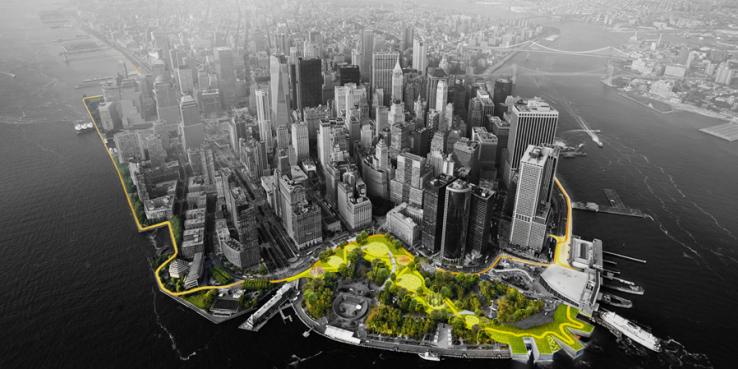Thanks to the threat of sea level rise, prolonged drought and the possibility of natural disaster brought on by climate change, the Bay Area could soon face devastating damage. How can we get ready for climate change before disaster strikes? At a recent evening forum, SPUR invited designers and city planners to discuss how the Bay Area could implement the lessons learned from the Rebuild By Design competition that helped revitalize the Northeast Coast after Hurricane Sandy.
In the last 30 years, the Bay Area has endured severe damage from natural disasters. In 1989 it was the historic magnitude 6.9 Loma Prieta earthquake, and in 1991 it was the destructive Oakland Hills fire. Darin Ranelletti of the City of Oakland Planning Department explained the important role these natural disasters played in Oakland’s demographic change. For example, compared to the rest of Oakland, the Dogtown neighborhood experienced an increase in wealth after the 1991 fire, while it simultaneously experienced a decrease in its African-American population. Resiliency, he stressed, must take social factors and equity into account, so recovery does not result in displacement.
Gil Kelley of the City of San Francisco Planning Department outlined the serious damage sea level rise could do to the Bay Area’s geography. For the next few decades, Kelley said, the planning department will focus its goals on equity, accessibility, livability and disaster resiliency. He strongly encouraged the community-based approach used by Rebuild By Design, as San Francisco’s vulnerable waterfront is critical to the collective Bay Area identity, as well as being an environmental asset. The waterfront is home to the San Francisco International Airport, BART and Muni, but also cherished places like the Embarcadero and historic homes. Kelley reported that local planning departments are currently developing plans to curb sea level rise, but before these plans are fully realized, they want to engage the community in order to create the best possible public spaces.
Amy Chester, design project manager of Rebuild By Design, spoke next about her experience after Hurricane Sandy and the lessons learned from disaster recovery. The competition brought more than a hundred design teams together to work with local organizations, philanthropic funders, and government bodies to improve specific areas in the region affected by Hurricane Sandy. Starting with valuable research and first-hand experience in the affected areas, the organizers of Rebuild By Design noticed that most cities in the region depended on each other for resources to stay afloat. Instead of simply building new infrastructure, Rebuild By Design focused on creating innovative ideas to keep the economy going and to better community networks and increase physical resilience to natural disasters. Widely recognized for its innovation, the design competition found its most significant success in strong community engagement. By sharing ideas and touring the areas, Rebuild by Design brought together a designer’s eye for renovation with local insight from the residents. Chester called this key takeaway “talent meets talent.” The engagement between design teams and local residents made for faster collaboration and well-informed design choices.
As the discussion closed, the panelists made a few things clear about infrastructure improvement in the Bay Area. First, designers need to listen to the community if they want to create functional and beloved urban spaces. Taking the time to research what the public wants is as valuable as any other step in the design process. Second, municipalities will need to work with each other in order to create the most comprehensive and well-built disaster prevention plans. Predictably, sea level rise will affect the whole region, so it is important for cities to work together as one. Third, professionals (be they scientists, engineers or designers) need to plan for more than just the threat of natural disaster. They need to make cities livable and functional for the days, weeks and months after the event — not only for the day disaster strikes.
